
An electronic calculator is typically a portable electronic device used to perform calculations, ranging from basic arithmetic to complex mathematics.

The TI-89 and the TI-89 Titanium are graphing calculators developed by Texas Instruments (TI). They are differentiated from most other TI graphing calculators by their computer algebra system, which allows symbolic manipulation of algebraic expressions—equations can be solved in terms of variables, whereas the TI-83/84 series can only give a numeric result.
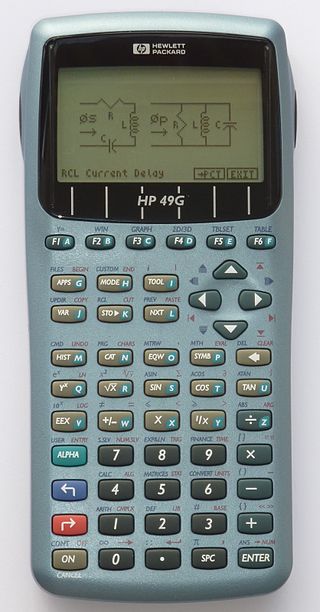
The HP 49/50 series are Hewlett-Packard (HP) manufactured graphing calculators. They are the successors of the popular HP 48 series.

A graphing calculator is a handheld computer that is capable of plotting graphs, solving simultaneous equations, and performing other tasks with variables. Most popular graphing calculators are programmable calculators, allowing the user to create customized programs, typically for scientific, engineering or education applications. They have large screens that display several lines of text and calculations.
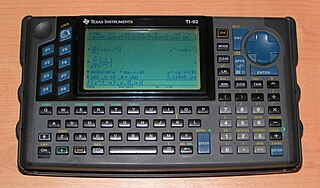
The TI-92 series of graphing calculators are a line of calculators produced by Texas Instruments. They include: the TI-92 (1995), the TI-92 II (1996), the TI-92 Plus and the Voyage 200 (2002). The design of these relatively large calculators includes a QWERTY keyboard. Because of this keyboard, it was given the status of a "computer" rather than "calculator" by American testing facilities and cannot be used on tests such as the SAT or AP Exams while the similar TI-89 can be.

A scientific calculator is an electronic calculator, either desktop or handheld, designed to perform mathematical operations. They have completely replaced slide rules and are used in both educational and professional settings.
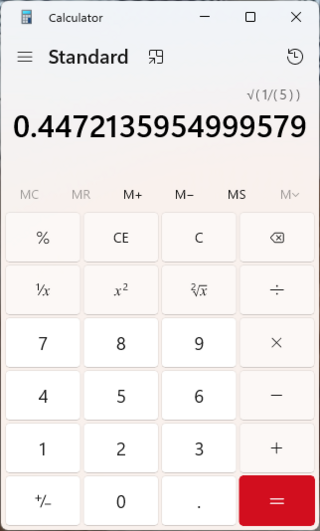
Windows Calculator is a software calculator developed by Microsoft and included in Windows. In its Windows 10 incarnation it has four modes: standard, scientific, programmer, and a graphing mode. The standard mode includes a number pad and buttons for performing arithmetic operations. The scientific mode takes this a step further and adds exponents and trigonometric function, and programmer mode allows the user to perform operations related to computer programming. In 2020, a graphing mode was added to the Calculator, allowing users to graph equations on a coordinate plane.

NuCalc, also known as Graphing Calculator, is a computer software tool made by the company Pacific Tech. The tool can perform many graphing calculator functions. It can graph inequalities and vector fields, as well as functions in two, three, or four dimensions. It supports several different coordinate systems, and can solve equations. It is available for OS X and Microsoft Windows.
There are various ways in which calculators interpret keystrokes. These can be categorized into two main types:

KCalc is the software calculator integrated with the KDE Gear. In the default view it includes a number pad, buttons for adding, subtracting, multiplying, and dividing, brackets, memory keys, percent, reciprocal, factorial, square, and x to the power of y buttons.
Programmable calculators are calculators that can automatically carry out a sequence of operations under control of a stored program. Most are Turing complete, and, as such, are theoretically general-purpose computers. However, their user interfaces and programming environments are specifically tailored to make performing small-scale numerical computations convenient, rather than general-purpose use.

The TI-Nspire is a graphing calculator line made by Texas Instruments, with the first version released in July 2007. The calculators feature a non-QWERTY keyboard and a different key-by-key layout than Texas Instruments's previous flagship calculators such as the TI-89 series.
HP 39/40 series are graphing calculators from Hewlett-Packard, the successors of HP 38G. The series consists of six calculators, which all have algebraic entry modes, and can perform numeric analysis together with varying degrees of symbolic calculation. All calculators in this series are aimed at high school level students and are characterized by their ability to download APLETs or E-lessons. These are programs of varying complexity which are generally intended to be used in the classroom to enhance the learning of mathematics by the graphical and/or numerical exploration of concepts.
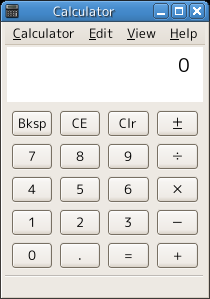
A software calculator is a calculator that has been implemented as a computer program, rather than as a physical hardware device.

A formula calculator is a software calculator that can perform a calculation in two steps:
- Enter the calculation by typing it in from the keyboard.
- Press a single button or key to see the final result.
In computing, a character set is a system of assigning numbers to characters so that text can be represented as a list of numbers. For example, ASCII assigns 61 to "A". As part of the design process, Texas Instruments (TI) decided to modify the base Latin-1 character set for use with its calculator interface. By adding symbols to the character set, it was possible to reduce design complexity as much more complex parsing would have to have been used otherwise.
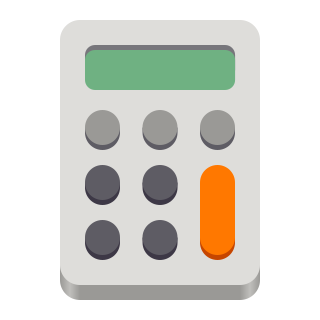
GNOME Calculator, formerly known as gcalctool, is the software calculator integrated with the GNOME desktop environment. It is programmed in C and Vala and part of the GNOME Core Applications.
The GNOME Core Applications are a software suite of approximately 30 application software that are packaged as part of the standard free and open-source GNOME desktop environment. GNOME Core Applications have the look and feel of the GNOME desktop, and often utilize the Adwaita design language. Some applications have been written from scratch and others are ports.
Casio calculator character sets are a group of character sets used by various Casio calculators and pocket computers.










